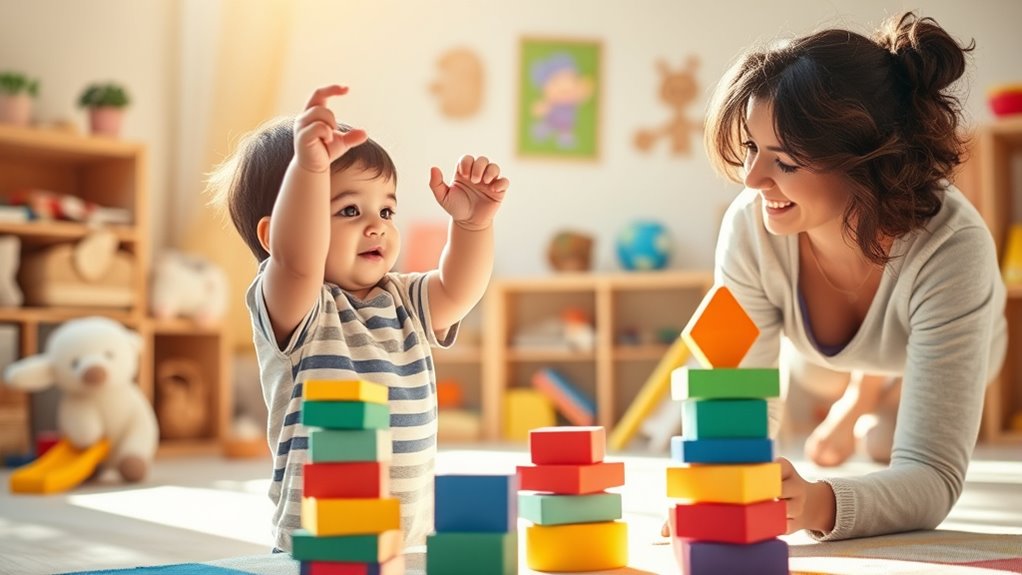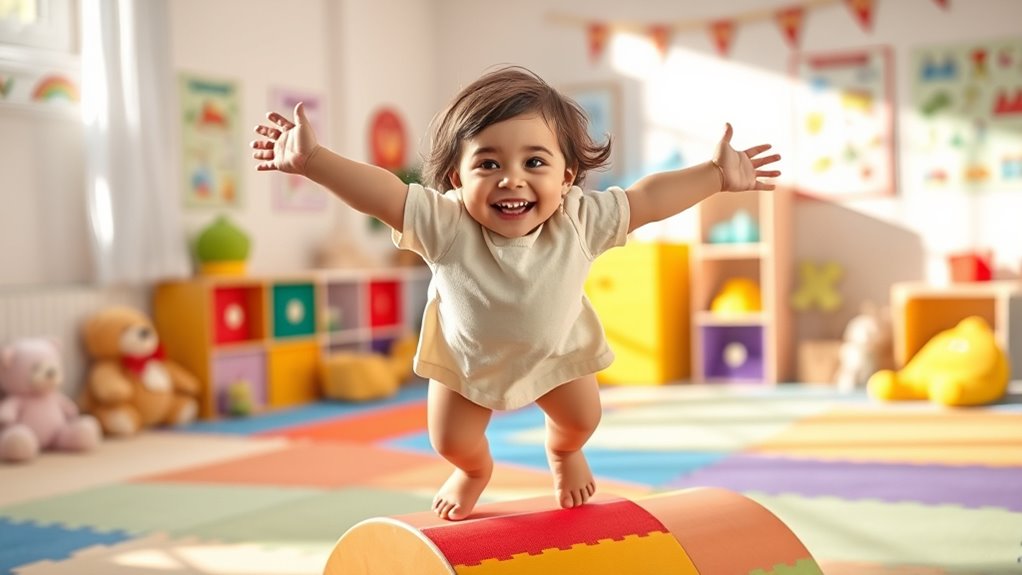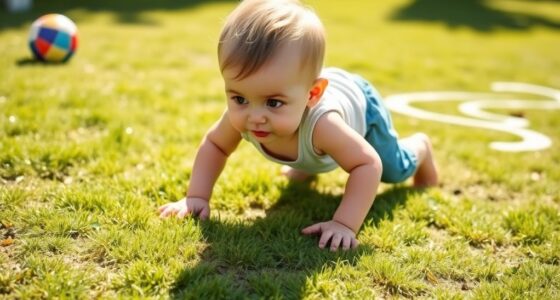Using play is a great way for you to encourage your child’s developmental milestones. Engaging in activities that promote sensory exploration, motor skills, and emotional regulation helps your child reach key goals like crawling, walking, and expressing feelings. By providing textured toys and interactive games, you stimulate brain connections and build confidence. Keep exploring different ways to support their growth, and you’ll discover even more effective play strategies along the way.
Key Takeaways
- Incorporate age-appropriate, sensorimotor activities that promote crawling, walking, and fine motor skills.
- Use textured toys and varied stimuli to enhance sensory exploration and brain development.
- Design playful challenges that gradually increase in difficulty to support milestone progression.
- Encourage social play to develop sharing, turn-taking, and emotional regulation skills.
- Provide a safe environment for experimentation, fostering confidence and resilience during milestone achievements.

Play is one of the most effective ways to support your child’s development and help them reach important milestones. When you engage your little one in play, you’re not just providing entertainment; you’re actively nurturing their sensorimotor development and emotional regulation. These early skills are fundamental for their overall growth and lay the groundwork for future learning and social interactions. Through play, your child learns to coordinate their senses and movements, which is essential for tasks like grasping objects, crawling, or walking. As they explore different textures, sounds, and sights, their brain makes essential connections, strengthening their sensorimotor skills. This exploration also encourages curiosity and confidence, motivating them to try new activities and discover their environment.
At the same time, play offers a safe space for your child to experience and manage their emotions. As they encounter success or frustration during activities, they develop emotional regulation—learning how to calm themselves when upset and celebrate their achievements. For example, when your child becomes frustrated because they can’t figure out how to fit a puzzle piece, you can guide them through calming techniques or offer reassurance, helping them understand their feelings and develop resilience. Play also provides opportunities for your child to practice social-emotional skills, such as sharing, taking turns, and expressing themselves. These interactions, whether with you or peers, help them recognize and manage their emotions in a social context.
You can support this process by choosing activities that challenge their sensorimotor skills—like stacking blocks, crawling through tunnels, or playing with textured toys—and by encouraging them to express their feelings during play. When your child throws a tantrum, instead of dismissing it, help them name their emotions and find ways to cope. This approach teaches emotional self-awareness and regulation, which are essential for their mental health and social development. Additionally, providing a variety of sensory experiences, such as playing with water, sand, or clay, stimulates their senses and enhances their sensorimotor integration, making it easier for them to navigate their world.
Furthermore, understanding the concept of critical periods in development can help you time activities to optimize your child’s learning and growth.
Frequently Asked Questions
How Can Parents Track Developmental Milestones During Play?
You can track developmental milestones during play by observing how your child engages in play therapy activities. Look for signs like improved motor skills, language use, and social interactions. Keep a milestone assessment checklist to record progress over time. Notice if your child reaches key milestones such as problem-solving or imitation. Regularly monitoring these behaviors helps you understand their development and identify areas where they may need extra support.
What Types of Play Are Most Effective for Specific Milestones?
You might wonder which play types unlock your child’s potential. Sensory play sparks exploration and fine motor skills, perfect for early milestones. Imaginative play nurtures creativity and social skills, essential for later development. Engaging in these activities at the right times creates a powerful connection, guiding your child through each milestone. Keep observing, and you’ll discover the secret to nurturing growth through play that truly resonates with their evolving needs.
How Do Cultural Differences Influence Play-Based Milestone Encouragement?
Cultural differences greatly influence how you use play to encourage milestones. You might observe cultural play practices that prioritize specific activities, shaping your approach. Traditional milestone celebrations often incorporate unique play elements that reinforce developmental goals. By understanding and respecting these cultural practices, you can create more meaningful, engaging play experiences that support children’s growth while honoring their cultural backgrounds. This approach fosters confidence and cultural identity alongside developmental progress.
When Should Parents Seek Professional Advice During Milestone Delays?
You should seek professional advice if you notice milestone delays, especially after your child’s age-specific expectations. Early intervention and developmental screening are vital steps; don’t wait if concerns persist. Contact a healthcare provider promptly if your child isn’t reaching key milestones like crawling or talking. Early support can make a big difference in your child’s development, so trust your instincts and act quickly when you suspect delays.
Are There Age-Appropriate Toys That Promote Milestone Achievement?
Age-appropriate toys truly boost milestone promotion. You’ll find that toys tailored to your child’s age, like stacking blocks for toddlers or puzzles for preschoolers, encourage essential skills. Playful, purposeful, and perfectly paced, these toys propel your child’s progress. By choosing age-appropriate toys, you create an engaging, constructive environment where your little one can confidently conquer milestones and develop vital cognitive, motor, and social skills with joy.
Conclusion
As you watch your little one explore, laughter bubbles up like a sparkling stream, and tiny hands grasp new challenges with curiosity. Play becomes the vibrant canvas where milestones are painted in bold, joyful strokes. Remember, each giggle, crawl, and first step is a brushstroke in this beautiful masterpiece. By nurturing their play, you’re opening a world of endless possibilities, guiding them gently toward a future filled with discovery and wonder.









